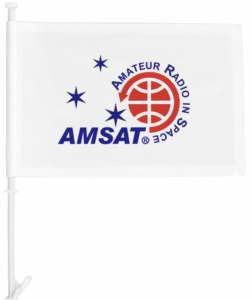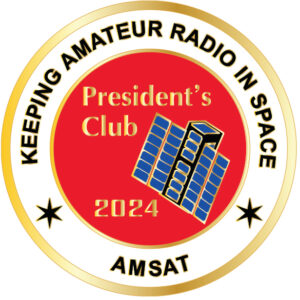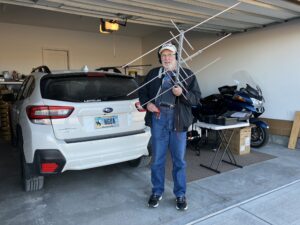In this edition:
* Microwave Ambitions for GOLF Satellites
* All-Ham Axiom Crew Launched for Commercial Visit to ISS
* AMSAT Argentina Celebrates 34 Years of LUSAT
* AMSAT Volunteers Needed For the Upcoming 2024 Orlando Hamcation
* IO-117 Project Group Presents the IO-117 Code of Conduct
* NASA Program Empowers Students for EZIE-Mag CubeSat Mission
* Changes to AMSAT-NA TLE Distribution for Jan. 18
* ARISS News
* Upcoming Satellite Operations
* Hamfests, Conventions, Maker Faires, and Other Events
* Satellite Shorts From All Over
The AMSAT News Service bulletins are a free, weekly news and information service of AMSAT, the Radio Amateur Satellite Corporation. ANS publishes news related to Amateur Radio in Space including reports on the activities of a worldwide group of Amateur Radio operators who share an active interest in designing, building, launching and communicating through analog and digital Amateur Radio satellites.
The news feed on http://www.amsat.org publishes news of Amateur Radio in Space as soon as our volunteers can post it.
Please send any amateur satellite news or reports to: ans-editor [at] amsat.org
You can sign up for free e-mail delivery of the AMSAT News Service Bulletins via the ANS List; to join this list see: https://mailman.amsat.org/postorius/lists/ans.amsat.org/
ANS-021 AMSAT News Service Weekly Bulletins
To: All RADIO AMATEURS
From: Radio Amateur Satellite Corporation
712 H Street NE, Suite 1653
Washington, DC 20002
DATE 2024 JAN 21
Microwave Ambitions for GOLF Satellites
Recently AMSAT News Service had the opportunity to interview Zach Metzinger, NØZGO, AMSAT Director and Volunteer Engineer, about the work that is being done to add microwave communication bands to the GOLF satellites.
ANS: “Zach, I understand that AMSAT will add microwave capability to the new GOLF CubeSat satellites, currently in design and evaluation. Is this correct?”
ZM: “Yes, that is correct! AMSAT had microwave capabilities in earlier satellites such as AO-10 and AO-40 and only a 1.2GHz downshifter on the newer CubeSats, that is the Fox series of satellites.
The GOLF (Greater Orbit Larger Footprint) satellites are currently under development.
GOLF-TEE is the first of these satellites and is the technology demonstrator for the GOLF series, which is in turn the successor to the FOX satellites. GOLF-TEE will have more capability as we increase the capability and functionality of our satellites, including adding microwave bands. “

ANS: “What is driving this increased functionality of the GOLF series?”
ZM: “Due to new orbital debris regulations, the FCC will require us to be able to be able to move as well as deorbit satellites, so we are adding the ability to orient and steer the satellite. While this adds complexity, it will also help us to improve the functionality of the satellite. For example: We will now be able to have the satellite maintain direction and orientation which will allow us to point the antenna for improved gain. This increased functionality is causing the increase in size. The GOLF satellites are a 3U size satellite, that is 30 cm x 10 cm x 10 cm. (The predecessor FOX satellites are 10 cm x 10 cm x 10 cm.) With the increase in size, we can also add other functionality, in this case the microwave capability we are discussing here today.”
ANS: “Can you tell us a little about how this is implemented?”
ZM: “While GOLF-TEE will have the usual 2m uplink and 70 cm downlink bands, it will also have an X-band (10 GHz) downlink transmitter. The 10 GHz SSPA board has already been demonstrated and works well. The 10 GHz SSPA has a peak power of 1 watt.
“We will also use a Software Defined Radio (SDR) which we will purchase. (For the development and demonstration, we have been using the Ettus E310 radio.) This will enable many simultaneous uplink bands, for example 1.2 GHz, 2.4 GHz, 5.7 GHz, etc. The whole system is very flexible. For example, the microwave antenna will support frequencies from 1 GHz to 26 GHz.”
ANS: “It is very exciting to hear about these improved capabilities. What are the next steps?”
ZM: “We continue to test the system and tweak the hardware. We will be ready to be on GOLF-TEE, which is estimated to launch in the second quarter of 2025. If it works well, it could be turned on for general use, but of course we will have to see. We definitely plan to have the microwave bands operational on succeeding GOLF satellites.
One more tidbit of information that folks may find interesting: The orbit for GOLF-TEE will be LEO. The next satellite, GOLF-1, could be LEO or perhaps MEO or HEO.
ANS: “This is an exciting development. How can we learn more?”
ZM: “I gave a 20-minute presentation on this at the AMSAT Annual Space Symposium, which you can see on YouTube.”
ANS: Thank you for your time, Zach!
Link to Zach Metzinger’s presentation is: https://www.youtube.com/watch?v=pcO4-h7bbxs&t=2270s
[ANS thanks Zach Metzinger, N0ZGO, AMSAT Director and Volunteer Engineer, and Mark Blackwood, KI5AXK, AMSAT Staff Writer, for the above information.]
All-Ham Axiom Crew Launched for Commercial Visit to ISS
With retired NASA astronaut Michael López-Alegría, KE5GTK, and Italian co-pilot Walter Villadei, IUØRWB, at the controls, flanked by Turkish mission specialists Alper Gezeravci, KJ5DIY, and Marcus Wandt of Sweden, KJ5COO, a SpaceX Falcon 9 thundered to life at 21:49 UTC Thursday and climbed away from historic pad 39A at the Kennedy Space Center atop a brilliant jet of flaming exhaust.
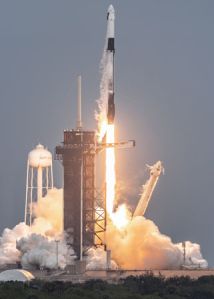
A Falcon 9 lifts off from Kennedy Space Center carrying an international crew on a commercial mission to the space station. Image: Adam Bernstein/Spaceflight Now.
Rocketing away along a trajectory paralleling the East Coast of the United States, the 12-minute climb to space got off to a picture-perfect start, thrilling area residents and tourists with a late-afternoon sky show despite low clouds that limited the view.
Adding to the spectacle, the booster’s first stage, heralded by twin sonic booms, flew itself back to a rocket-powered landing at the Cape Canaveral Space Force Station, chalking up SpaceX’s 43rd landing in Florida and its 265th overall.
A few minutes later, the Crew Dragon capsule was released to fly on its own. SpaceX Chief Engineer Bill Gerstenmaier radioed congratulations to the crew “on a great ride to orbit. I think you’re demonstrating the ultimate in reuse — a reused commander, reused Dragon and a reused Falcon.”
If all goes well, López-Alegría and Villadei will monitor an automated approach to the space station, catching up from behind and below to set up a docking at the lab’s forward port early Saturday.
They’ll be welcomed aboard by the station’s current seven-member crew: Soyuz MS-24/70S commander Oleg Kononenko, RN3DX, and his two crewmates, Nikolai Chub and NASA astronaut Loral O’Hara, KI5TOM, along with NASA Crew-7 commander Jasmin Moghbeli, KI5WSL, European Space Agency astronaut Andreas Mogensen, KG5GCZ, Japanese flier Satoshi Furukawa, KE5DAW, and cosmonaut Konstantin Borisov.
At least two ARISS school contacts are scheduled with Axiom crewmembers, and participants in previous Axiom missions have activated the ARISS equipment on board the Space Station for casual contacts in the past.
Once their experiments are complete, López-Alegría and his crewmates will strap back into their Crew Dragon and undock from the space station on Feb. 3 for a fiery plunge back to Earth and splashdown off the coast of Florida.
The Axiom flights are sanctioned by NASA, which is trying to encourage private-sector development in low-Earth orbit. The company is using the “private astronaut missions,” or PAMs, to gain experience with orbital operations before launching its own space station modules later this decade.
[ANS thanks spaceflightnow.com for the above information]
+=+=+=+=+=+=+=+=+=+=+=+=+=+=+=+=+=+=+=+=+=+=+=+=+=+=+=+=+=+=+=+=+=+=+
The 2024 AMSAT President’s Club coins are here now!
Help Support GOLF and Fox Plus
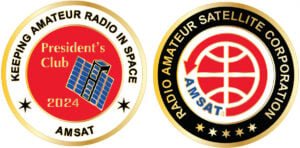 Join the AMSAT President’s Club today and help
Join the AMSAT President’s Club today and help
Keep Amateur Radio in Space!
https://www.amsat.org/join-the-amsat-presidents-club/
+=+=+=+=+=+=+=+=+=+=+=+=+=+=+=+=+=+=+=+=+=+=+=+=+=+=+=+=+=+=+=+=+=+=+
AMSAT Argentina Celebrates 34 Years of LUSAT
On Jan-22, 34 years ago was launched LO-19, LUSAT, 1st Argentine Satellite, till now emitting on 437.125 KHz.
During ‘LUSAT Week’, from Saturday-20 to Sunday-28 January 2024, AMSAT-LU, several Radio Clubs and collaborators will deliver a QSL commemorative of the 34rd anniversary of LUSAT, see: lusat33qsl.jpg, and the 34rd anniversary silver certificate with 5 (five) contacts or gold with 15 (fifteen) contacts, it will not be mandatory to communicate with LU7AA.
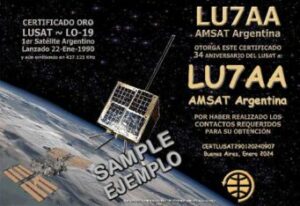
This Certificate complies with all the requirements of Argentine Resolution 3635-E/2017, articles 4.5.4 and 4.6.4, and therefore having LU7AA in force Legal Status and being recognized by ENACOM is valid for category promotions.
It will be operated by radio means of the radio amateur service only, in multiband/multimode, terrestrial HF/VHF/UHF and via active amateur satellites. More information at LU7AA at qrz.com. Collaborators will be calling: ‘LUxxx collaborating station of AMSAT Argentina, grants Commemorative QSL for the 34rd Anniversary of LUSAT’.
Do not miss this Certificate or QSL like the previous ones, it will be a pride to have it and for AMSAT your participation. Radio clubs and radio amateurs were invited to operate as a collaborating station.
To sign up as a Collaborating station see: https://forms.gle/iyEYE5F3gskmRdkQ8
Bases:
To obtain the QSL you must contact a collaborating station, or as a short wave listener receive a QSO between stations related to the 34rd anniversary event of LUSAT.
To obtain the Certificate, it will be necessary to contact (Radio amateurs) or listen (Short Wave Listeners) by radio at least 5 collaborating stations (silver), or 15 stations (gold) in any band and mode.
Finalized contacts or listening and after January 29:
For radio amateurs, go to https://forms.gle/c2RJE5LyBqz5erh7A and inform your contacts, it is not necessary to send QSLs or images.
For Short Wave Listeners, go to https://forms.gle/pkHNsQuWRo4MB21DA and report your listen stations, it is not necessary to send QSLs or images.
Issuance of the Certificate:
The LUSAT 34rd Anniversary Certificate will be issued free of charge, digitally to the email of each applicant. The Certificate can be printed by the recipient if desired.
More information and images: http://amsat.org.ar?f=34
Celebrating its permanence in space, our LUSAT continues to emit a strong carrier after 34 years, receivable at 437.125 KHz. +/- Doppler.
See pass schedules at http://amsat.org.ar/pass?satx=LUSAT
Details: http://amsat.org.ar?f=34 http://qrz.com/db/LU7AA https://www.qrzcq.com/call/LU7AA (also in English)
Collaborating stations registration open at https://forms.gle/iyEYE5F3gskmRdkQ8
LUSAT could be tracked/seen thru http://amsat.org.ar/pass?satx=lusat
Deeply appreciation to AMSAT-NA than in the eighties develop AO-16 & LO-19 novel pacsat protocol and lead on design and launch.
[ANS thanks AMSAT Argentina, LU7AA, for the above information]
+=+=+=+=+=+=+=+=+=+=+=+=+=+=+=+=+=+=+=+=+=+=+=+=+=+=+=+=+=+=+=+=+=+
Need new satellite antennas?
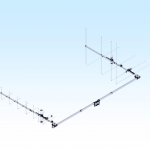
Purchase Arrows, Alaskan Arrows,
and M2 LEO-Packs from the AMSAT Store. When you purchase through
AMSAT, a portion of the proceeds goes towards
Keeping Amateur Radio in Space.
https://amsat.org/product-category/hardware/
+=+=+=+=+=+=+=+=+=+=+=+=+=+=+=+=+=+=+=+=+=+=+=+=+=+=+=+=+=+=+=+=+=+
AMSAT Volunteers Needed For the Upcoming 2024 Orlando Hamcation
The new year is now upon us and that means the 2024 HamCation in Orlando, Florida (Feb. 9 – 11) is just around the corner. The hamfest began in 1946 and in 2024 celebrates its 78th year having achieved the designation as being the 2nd largest gathering of ham operators in the world annually.

Along with a myriad of popular amateur radio vendors and enormous tailgate area to peruse through, AMSAT will also be on hand and we could sure use your help. If last year’s 21,800 attendees are any indication of what’s ahead, we would greatly appreciate you sharing at least 2 to 4 hours of your time at the AMSAT booth sometime during the three-day event, introducing fellow hams to what amateur satellites are all about, helping those who maybe having problems getting on the air and best of all, connecting face to face with hams you’ve talked to on the satellites.
So if you would like to join us at the AMSAT booth or have any questions about helping out, please contact David Jordan, AA4KN at [email protected].
BTW, the average temp. for Orlando in February is a high 75 deg. and low 54 deg.
… hard to beat that!!
For more details on 2024 HamCation, visit https://www.hamcation.org
[ANS thanks Dave Jordan, AA4KN, AMSAT Ambassador in Central Florida for the above information]
IO-117 Project Group Presents the IO-117 Code of Conduct
A group of amateurs who regularly work the IO-117 satellite has worked to develop a code of conduct for using this popular digipeating resource.
The purpose of the IO-117 Code of Conduct document is to provide suggested operational guidelines that will hopefully optimize everyone’s access to the limited resource single channel digipeater aboard IO-117. If better messaging discipline can be adopted as well as a better understanding of what operating techniques improve or diminish the success of a station’s transmission being digipeated by IO-117, then the entire group of operators on an individual pass will benefit from implementing these standards.
Those involved in this project, in alphabetical order, are: 2MØSQL, DF2ET, FG8OJ, IK3ITB, JH8FIH, JK2XXK, KF7R, KGØD, KH6WI, KIØKB, OZ9AAR, and W8LR.
IO-117 CODE OF CONDUCT
1. LISTEN MORE TRANSMIT LESS – Consider giving the station you are calling several minutes to return Your call before you call again. The use of Greencube Terminal program by OZ9AAR (GC-T) with its “yoU Heard Me” feature (UHM — available in the latest GC-T version, 1.0.0.85) turned on may aid in this process. The software is available for free download at: https://www.moonbounce.dk/hamradio/greencube-terminal-program.html
2. STATIONS SHOULD USE THE MINIMAL POWER NECESSARY TO ACCESS THE SATELLITE.
3. AVOID CALLING CQ MORE THAN ONCE EVERY 5 MINUTES.
4. AVOID DUPE QSOs – Other than occasional contacts with friends and for testing purposes we should discourage repeat contacts with stations already confirmed in your log, particularly for uncommon or rare DX stations.
5. AVOID 2X – 3X IDENTICAL TRANSMISSIONS IN BACK TO BACK TO BACK DIGIPEATS BY ANY MEANS. The
Use of GC-T/UHM ABSOLUTLEY helps you avoid this problem.
6. WHEN CALLING A STATION, TIME YOUR TX TO WHEN THEY WILL MOST LIKELY BE LISTENING FOR NEW CALLS. AFTER THEY SEND A CQ OR SEND ANOTHER STATION THEIR R73 TX.
7. KEEP MESSAGES AS SHORT AS POSSIBLE – Every millisecond saved does make a difference. Four character grids only, not six characters.
8. AVOID SENDING SUPERFLUOUS DATA – 599 is irrelevant on a digipeater. Avoid sending operator names. Use 2-Letter ID for states; don’t include city or regional quantifiers (ie: “SoCal”, just send “CA”). You can shorten “UR 599, DN84fj, Sturgis South Dakota, LoTW, QSL?” to “DN84 SD” with no loss of relevant information for the QSO.
9. CALLING FOR A SPECIFIC STATE IS UNNECESSARY AND UNPRODUCTIVE – That info is available on GC-T and the Greencube Reporter: https://oscarwatch.org/greencube/.
10. WHEN A STATION DECLARES “SKED” IN THE TX MESSAGE DO NOT CALL THAT STATION UNTIL THEY HAVE FINISHED THEIR SCHEDULED CONTACT – Both stations should use SKED GRID in message & use COSI (Callsign of Special Interest).
11. WHEN WORKING A RARE CALL/GRID STATION THAT IS USING THE GC-T MULTICALL FEATURE THEIR “R73” TRANSMISSION SHOULD BE ADEQUATE TO FINISH THE QSO: GC F/H Mode: similar to FT8 F/H mode.
12. FOR ROVERS, PUTTING YOUR ROVING GRID IN THE “R73” TRANMISSION IS ACCEPTABLE, AS WELL AS BEING HELPFUL, TO ALL STATIONS COMING INTO THE FOOTPRINT.
13. SUGGESTED MESSAGE FORMAT: FT8 Format (GC F/H Mode) and GRID Format: 4 Characters only NOT 6
Calling Message:
P5ABC CQ PM39
P5ABC 3Y0ABC PM39.
P5ABC 3Y0ABC/R/P PM39
Response 73 Message: 3Y0ABC P5ABC R73 or RR73
3Y0ABC/R/P P5ABC R73 JD15
14. AS A FORM OF COURTESY, THE R73 EXCHANGE IS USUALLY BILATERAL BUT ONE MUST TAKE INTO ACCOUNT THE CURRENT SITUATION OF THE SATELLITE, SO THE LAST R73 MAY BE WELCOMED BUT NOT MANDATORY – The use of GC-T/UHM may aid you in this decision process.
15. ROVERS SHOULD ATTEMPT TO PROVIDE THE BEST POSSIBLE STATION, TO INCLUDE THE USE OF THE GC-T/UHM FEATURE WHEN INTERNET ACCESS IS AVAILABLE, IN ORDER TO MAKE AN IO-117 ACTIVATION PRODUCTIVE AS POSSIBLE FOR ALL STATIONS INVOLVED.
[ANS thanks Jeff Schwartz, KI0KB, and the IO-117 Project Group for the above information.]
+=+=+=+=+=+=+=+=+=+=+=+=+=+=+=+=+=+=+=+=+=+=+=+=+=+=+=+=+=+=+=+=+=+
Want to fly the colors on your own grid expedition?
Get your AMSAT car flag and other neat stuff
from our Zazzle store!
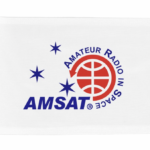
25% of the purchase price of each product goes
towards Keeping Amateur Radio in Space
https://www.zazzle.com/amsat_gear
+=+=+=+=+=+=+=+=+=+=+=+=+=+=+=+=+=+=+=+=+=+=+=+=+=+=+=+=+=+=+=+=+=+
NASA Program Empowers Students for EZIE-Mag CubeSat Mission
The Electrojet Zeeman Imaging Explorer (EZIE) team at Johns Hopkins Applied Physics Laboratory (APL) is extending an invitation to citizen scientists, schools, and researchers to actively participate in NASA’s CubeSat mission set to capture the magnetic signatures of Earth’s upper atmosphere. The project, known as EZIE-Mag, is distributing 700 Raspberry Pi-powered experimentation kits, providing an unprecedented opportunity for enthusiasts to contribute valuable ground-based readings to the mission.
Dr. Nelli Mosavi-Hoyer, project manager for EZIE at Johns Hopkins APL, emphasizes the importance of citizen scientists’ involvement, stating, “EZIE-Mag provides the mission with a unique opportunity to engage citizen scientists in this important research. Measurements made by these kits will be complementary to data collected by the three EZIE spacecraft.”
The core of NASA’s Electrojet Zeeman Imaging Explorer program consists of three CubeSats, scheduled for launch in the late stages of 2024. These CubeSats will play a pivotal role in recording the magnetic fingerprints of Earth’s auroral electrojets – electrical currents flowing between the outer limits of the atmosphere and surrounding space. While the CubeSats map these currents, the EZIE-MAG initiative aims to enhance the mission with additional ground-based data.
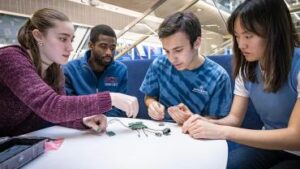
Adebayo Eisape, second from left, an electrical engineering doctoral student at Johns Hopkins University, watches as high school students with the Lab’s ASPIRE program assemble the EZIE-Mag kit. (Image credit: Ed Whitman/Johns Hopkins University Applied Physics Laboratory)
Dr. Jesper Gjerloev, EZIE project scientist, stresses the inclusive nature of involving citizen scientists in the project, highlighting that it was previously considered unfeasible due to the high costs of custom equipment, ranging from $25,000 to $500,000. The innovative solution involved creating a low-cost sensor connected to a Raspberry Pi Zero single-board computer.
EZIE ground systems engineer Rob Barnes, inspired by a science fair project with his niece and nephew, developed prototypes for the EZIE-Mag kits. These kits, priced at just $200, include a low-cost magnetometer sensor paired with GPS for accurate time and location data, connected to a Raspberry Pi Zero. The cost reduction allows the team to distribute the kits to schools free of charge.
Barnes explains, “When we distribute EZIE-Mags, the data that’s going to come in from all these schools and places is actually going to be included as part of the mission database. We’re going to do real science with it. You get all the parts and they just snap together, and you’re done.”
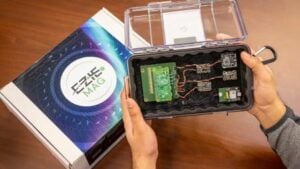
The EZIE team will make and freely distribute approximately 700 EZIE-Mag kits to teachers and students across the United States, with a specific focus on Indigenous schools. (Image credit: NASA/Johns Hopkins University Applied Physics Laboratory/Ed Whitman)
The EZIE-Mag program has also formed partnerships with the Indigenous Education Institute and Little Singer Community School, establishing five Indigenous-based collaborative workspaces equipped with EZIE-Mag kits. In total, up to 700 kits will be distributed to schools in underserved communities.
Dr. Gjerloev applauds the active participation of schools, stating, “They’re actively participating, providing data that is used in our solutions. As a middle schooler or high schooler, you can say, ‘I’m actually providing data and making measurements that are important and being used for a NASA mission.’ That’s the way it should be. It’s much more exciting than sending out a flyer.”
For those interested in joining the EZIE-Mag project, further information and an application form for the kit are available on the project website: https://ezie.jhuapl.edu/outreach/ezie-mag.
[ANS thanks Gareth Halfacree, hackster.io, for the above information]
Changes to AMSAT-NA TLE Distribution for Jan. 18
Two Line Elements or TLEs, often referred to as Keplerian elements or keps in the amateur community, are the inputs to the SGP4 standard mathematical model of spacecraft orbits used by most amateur tracking programs. Weekly updates are completely adequate for most amateur satellites. TLE bulletin files are updated daily in the first hour of the UTC day. New bulletin files will be posted immediately after reliable elements become available for new amateur satellites. More information may be found at https://www.amsat.org/keplerian-elements-resources/.
This week there are no additions or deletions to the AMSAT TLE distribution.
[ANS thanks AMSAT Orbital Elements page for the above information]
ARISS NEWS
Amateurs and others around the world may listen in on contacts between amateurs operating in schools and allowing students to interact with astronauts and cosmonauts aboard the International Space Station. The downlink frequency on which to listen is 145.800 MHz worldwide.
IC Statale Villa Guardia, Villa Guardia, Italy, telebridge via ZS6JON
The ISS callsign is presently scheduled to be NA1SS
The scheduled crewmember is Walter Villadei, IUØRWB
The ARISS mentor is IZ2GOJ
Contact is go for: Mon 2024-01-22 09:35:49 UTC 44 degrees elevation
Watch for Livestream at https://www.youtube.com/watch?v=gMQUWMww9yE
Istituto Comprensivo “Anna Rita Sidoti”, Gioiosa Marea, Italy, direct via IT9DBI
The ISS callsign is presently scheduled to be IRØISS
The scheduled crewmember is Walter Villadei, IUØRWB
The ARISS mentor is IKØWGF
Contact is go for: Wed 2024-01-24 14:37:22 UTC 40 degrees elevation
Youth Group, Nizhny Novgorod, Russia, direct via TBD
The ISS callsign is presently scheduled to be RSØISS
The scheduled crewmember is Konstantin Borisov
The ARISS mentor is RV3DR
Contact is go for Thu 2024-01-25 15:30 UTC
The crossband repeater continues to be active (145.990 MHz up {PL 67} & 437.800 MHz down). If any crewmember is so inclined, all they have to do is pick up the microphone, raise the volume up, and talk on the crossband repeater. So give a listen, you just never know.
The packet system Temporarily stowed. (145.825 MHz up & down). SSTV Status is OFF.
As always, if there is an EVA, a docking, or an undocking; the ARISS radios are turned off as part of the safety protocol.
Note, all times are approximate. It is recommended that you do your own orbital prediction or start listening about 10 minutes before the listed time.
The latest information on the operation mode can be found at https://www.ariss.org/current-status-of-iss-stations.html
The latest list of frequencies in use can be found at https://www.ariss.org/contact-the-iss.html
[ANS thanks Charlie Sufana, AJ9N, one of the ARISS operation team mentors for the above information]
Upcoming Satellite Operations
None scheduled at this time.
[ANS thanks Ian Parsons, K5ZM, AMSAT rover page manager, for the above information]
Hamfests, Conventions, Maker Faires, and Other Events
AMSAT Ambassadors provide presentations, demonstrate communicating through amateur satellites, and host information tables at club meetings, hamfests, conventions, maker faires, and other events.
+ Orlando HamCation 2024
Friday February 9th through Sunday February 11th, 2024
Central Florida Fairgrounds and Expo Park
4603 West Colonial Drive
Orlando, Florida 32808
https://www.hamcation.com
+ 40th Anniversary Celebration of the Positive Impact of Amateur Radio on Human Spaceflight
Thursday February 22nd through Saturday February 24th, 2024
Center for Space Education: Astronauts Memorial Foundation
Kennedy Space Center, M6-306 405 State Road, FL 32899
https://www.ariss.org/overview.html
+ Dayton Hamvention 2024
Friday May 17th through Sunday May 19th, 2024
Greene County Fairgrounds and Expo Center
120 Fairground Road
Xenia, OH 45385
https://hamvention.org
[ANS thanks the AMSAT Events page for the above information]
Satellite Shorts From All Over
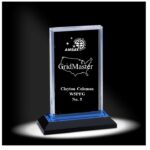 + Congratulations to Lyle Hood, WB7VUF, for being awarded GridMaster Award #63! This prestigious award, introduced by Star Comm Group in 2014 and sponsored by Damon Runion, WA4HFN, and Rick Tillman, WA4NVM, is now entrusted to AMSAT for the benefit of the entire AMSAT community. The GridMaster Award recognizes amateurs worldwide who establish two-way communication via amateur satellite with operators in all 488 Maidenhead grids in the contiguous United States of America. More information about this award can be found on the AMSAT website at https://www.amsat.org/gridmaster. Well done on this remarkable achievement Lyle! (ANS thanks Bruce Paige, KK5DO, AMSAT Director of Contests and Awards for the above information)
+ Congratulations to Lyle Hood, WB7VUF, for being awarded GridMaster Award #63! This prestigious award, introduced by Star Comm Group in 2014 and sponsored by Damon Runion, WA4HFN, and Rick Tillman, WA4NVM, is now entrusted to AMSAT for the benefit of the entire AMSAT community. The GridMaster Award recognizes amateurs worldwide who establish two-way communication via amateur satellite with operators in all 488 Maidenhead grids in the contiguous United States of America. More information about this award can be found on the AMSAT website at https://www.amsat.org/gridmaster. Well done on this remarkable achievement Lyle! (ANS thanks Bruce Paige, KK5DO, AMSAT Director of Contests and Awards for the above information)
+ Kudos to Tom Kenny, NJ2DX, on achieving AMSAT Century Award #60! This distinguished recognition entails confirming satellite contacts with a mix of one hundred USA states, Canadian provinces, or DXCC entities. Tom met the requirements for the AMSAT Satellite Communications Achievement Award and AMSAT Sexagesimal Award by respectively establishing satellite contacts with twenty and sixty distinct entities from within a 40-kilometer radius of the same location, paving the way for eligibility for this distinguished honor. For more information about this award, please visit the AMSAT website at https://www.amsat.org/awards. Once again, congratulations to Tom on this exceptional accomplishment! (ANS thanks Bruce Paige, KK5DO, AMSAT Director of Contests and Awards for the above information)
+ Astrobotic’s Peregrine moon lander was launched on January 8 under an experimental new partnership between NASA and private industry intended to reduce costs for American taxpayers and seed a lunar economy. But it experienced an explosion shortly after separating from its rocket and had been leaking fuel, making it impossible to reach its destination. Astrobotic announced that it had lost contact with its spacecraft shortly before 2100 GMT Thursday, January 18, indicating a “controlled re-entry over open water” as it had predicted. Engineers had executed a series of small engine burns to position the golf cart-sized robot over the South Pacific to “minimize the risk of debris reaching land.” (ANS thanks Space Daily for the above information)
+ After a leisurely, fuel-efficient trip to the Moon, the Japan Aerospace Exploration Agency (JAXA) SLIM lander (aka “Moon Sniper”) attempted a pinpoint landing at 15:20 UTC on Jan. 19. Pinpoint in this context means shooting for a landing area ellipse of 100 x 100 meters after a 20-minute autonomous descent process. That’s a smaller target area than ever attempted by a lunar lander, though China’s Chang’e 3 lander managed to land 89 meters from the center of its 6,000 x 6,000 meter target in 2013. While the soft landing was a success, JAXA is still analyzing data to determine the precision of the landing. (ANS thanks The Orbital Index and JAXA for the above information)
+ The Chinese Academy of Sciences, ESA, and the Max Planck Institute for Extraterrestrial Physics in Germany collaborated on the Einstein Probe, an X-ray telescope that launched last week on a Long March 2C. The telescope will observe X-ray bursts from energetic sources such as neutron star mergers and black holes and will monitor how these change over time. It will orbit Earth at 600 km and carry two instruments. The Wide-field X-ray Telescope (WXT) uses hundreds of thousands of square fibers “inspired by the eyes of lobsters” which can collectively image almost a tenth of the celestial sphere at a time. Once sources are identified, they can be imaged in more detail with the narrower but more sensitive, two-module Follow-up X-ray Telescope (FXT). (ANS thanks The Orbital Index for the above information)
Join AMSAT today at https://launch.amsat.org/
In addition to regular membership, AMSAT offers membership to:
* Societies (a recognized group, clubs or organization).
* Primary and secondary school students are eligible for membership at one-half the standard yearly rate.
* Post-secondary school students enrolled in at least half time status shall be eligible for the student rate for a maximum of 6 post-secondary years in this status.
* Memberships are available for annual and lifetime terms.
Contact info [at] amsat.org for additional membership information.
73 and remember to help Keep Amateur Radio in Space!
This week’s ANS Editor, Mark Johns, KØJM
k0jm [at] amsat.org
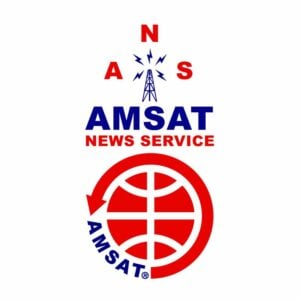



 Join the AMSAT President’s Club today and help
Join the AMSAT President’s Club today and help






 + Congratulations to Lyle Hood, WB7VUF, for being awarded GridMaster Award #63! This prestigious award, introduced by Star Comm Group in 2014 and sponsored by Damon Runion, WA4HFN, and Rick Tillman, WA4NVM, is now entrusted to AMSAT for the benefit of the entire AMSAT community. The GridMaster Award recognizes amateurs worldwide who establish two-way communication via amateur satellite with operators in all 488 Maidenhead grids in the contiguous United States of America. More information about this award can be found on the AMSAT website at
+ Congratulations to Lyle Hood, WB7VUF, for being awarded GridMaster Award #63! This prestigious award, introduced by Star Comm Group in 2014 and sponsored by Damon Runion, WA4HFN, and Rick Tillman, WA4NVM, is now entrusted to AMSAT for the benefit of the entire AMSAT community. The GridMaster Award recognizes amateurs worldwide who establish two-way communication via amateur satellite with operators in all 488 Maidenhead grids in the contiguous United States of America. More information about this award can be found on the AMSAT website at 
